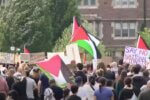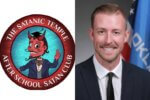Bible believers love prophecy.
We read millions of books that have been written about prophecy. We attend prophecy conferences. We watch videos and movies about prophecy. Yet so many believers don’t understand a key to understanding biblical prophecy that I will be sharing with you.
While this key to unlocking prophecy is clearly shown in the Bible over and over, it is rarely taught to those seeking to understand prophecy. The result of not understanding this key results in misunderstanding prophecy, which has resulted in really bad eschatology, and in many cases has caused division within the body of Messiah.
In order to understand and use this key to reveal the prophetic we must understand that prophecy is cyclical and not linear. In other words, the prophetic is seen as a circle not as a line. This is the problem with prophecy timelines.
To understand the cyclical nature of the Bible and prophecy we must remember that the Bible only speaks of two seasons: seedtime and harvest. There are two halves of the year, not four quarters. The first season includes Passover and Shavuot or Pentecost, and the other season includes Yom Teruah or The Day of Trumpets also known as Rosh Hashanah, New Years and Sukkot or Tabernacles.
While many people know that biblically there are only two seasons, many do not know that these two seasons mirror each other. The first season begins with Passover and ends with Shavuot. The second begins with Yom Teruah and ends with Sukkot.
The first starts with an eight-day-long celebration and ends with the blowing of the shofar. The second begins with the blowing of the shofar and ends with an eight-day-long celebration. These events are cyclical, not linear. There is no beginning and no ending, just a continuing.
Now there are many prophetic revelations within these appointed times especially in light of their mirroring one another, but for the purpose of this article, I will be focusing primarily on one.
In order to understand this prophetic cycle, we must remember that Passover is the celebration of the redemption of Israel from Egypt and the creation of the nation of Israel. When the children of Israel entered Egypt they were a family, after they left Egypt G-D makes them a nation.
After they leave Egypt, they live in tabernacles. So, in the spring appointed times we see a creation narrative and a tabernacle narrative. Likewise in the fall appointed times we see a creation narrative Rosh Hashanah (creation of Adam/mankind) and a tabernacle narrative as we build and live in Sukkot.
We are taught that Rosh Hashanah is the celebration of the New Years of the creation of Adam or mankind. So. this year is 5783 from the creation of Adam. However, the commandment for observing Yom Teruah doesn’t come until more than 1,400 years after Adam is created when the Torah was given on Mount Sinai and the nation Israel is created.
So, we see two creation narratives, one in the fall and one in the spring both observed by the blowing of the shofar. In the spring we celebrate the redemption of Israel by celebrating Passover, Unleavened Bread and Pentecost, and in the Fall we celebrate the redemption of Israel by dwelling in tabernacles.
You may be reading this and saying, “that’s cool. but how does it relate to me?” These appointed times were all given to reveal deeper prophetic events. Each is fulfilled in Yeshua such as the birth, His death and resurrection, the outpouring of the Holy Spirit and ultimately His return.
Because biblical prophecies are cyclical most have more than one single fulfillment. These cyclical prophecies not only take us from Adam’s creation in the garden to the creation of Israel as a nation, they also show us the pattern for our redemption.
As we celebrate Rosh Hashanah. we remember our physical birth and creation just as Adam was created. Then we celebrate Yom Kippur the Day of Atonement/Judgment just as Adam was judged for his sin, we are judged guilty of sin. But on Tabernacles, we remember G-D’s deliverance from Egypt which holds a promise of our deliverance from sin. Likewise, the mirror of the spring appointed times they reiterate the same pattern for us.
The questions are: “Why do these prophetic events mirror each other instead of staying in the same format?” “Why, when we have a New Year in the fall did G-D then give us a New New Year in the spring?” There is nothing extra in the Bible if G-D added a new New Year. He did it for a reason, and that reason was important to us His creation.
What if Yom Teruah in the fall represents man’s creation and Shavuot in the spring represents man’s recreation or new birth?
What if the tabernacle feast in the fall represents Yeshua’s first coming and the tabernacle feast in the spring represents Yeshua’s second coming?
What if G-D designed these appointed times as that. Prophetically, He would show us His plan for the redemption of man and our need to be not only born, but also reborn? {eoa}
Eric Tokajer is the author of Overcoming Fearlessness, What If Everything You Were Taught About the Ten Commandments Was Wrong?, With Me in Paradise, Transient Singularity, OY! How Did I Get Here?: Thirty-One Things I Wish Someone Had Told Me Before Entering Ministry, #ManWisdom: With Eric Tokajer, Jesus Is to Christianity as Pasta Is to Italians and Galatians in Context.








Leave a Comment
You must be logged in to post a comment.